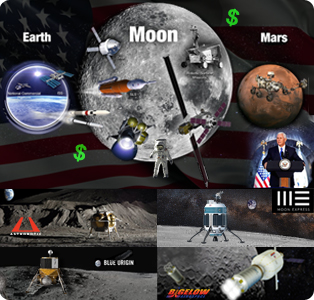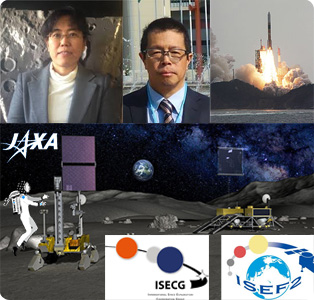USA Prioritizing Human Return to Moon ~2023, Cislunar Gateway, Private-Public Partnerships
|
MONDAY Ongoing…
|

![]() = All times
= All times
for terrestrial events in local time unless noted.
![]() = All times for international terrestrial events in local time unless noted.
= All times for international terrestrial events in local time unless noted.
![]() = All times for space events, and…
= All times for space events, and…
![]() = All times for international space / astro events in Hawaii Standard Time unless noted. Add 10 hours to obtain UT (‘Universal Time’).
= All times for international space / astro events in Hawaii Standard Time unless noted. Add 10 hours to obtain UT (‘Universal Time’).
Weekly Planet Watch – Evening Planets: Venus (WSW), Uranus (SW); Morning Planets: Mars (ESE), Jupiter (ESE), Saturn (SE).
JAXA Holds Workshops On Global Exploration Roadmap & Lunar Polar Exploration
On February 18 and 19, JAXA is convening two all-day public workshops in Tokyo, one to introduce the status of Global Exploration Roadmap (GER) and another to discuss exploration of the polar regions of the Moon. GER is being developed by International Space Exploration Coordination Group (ISECG), which is facilitating discussions among 14 space agencies to expand human presence into the Solar System through coordinated effort. January 2018 edition of GER “reflects consensus about the importance of the Moon on the pathway to Mars”. The Feb 19 workshop on exploration of lunar polar region is the 2nd one following a 2-day workshop on this topic held on Dec 8-9, 2017. It will draw on results from the previous event to deepen discussion toward realizing international collaboration related to scientific instruments and exploration vehicles for investigating water ice at the poles. The GER workshop will be led by JAXA international space exploration advancement team head Naoki Sato (R), and the lunar polar workshop by JAXA scientist Makiko Ohtake (L) and university professors. Also on the horizon this week for Japan is the launch of H-2A rocket #38 from Tanegashima Space Center, scheduled for Feb 25. It will deliver Information Gathering Satellite – Optical 6. Finally, Japanese government is preparing for the 2nd International Space Exploration Forum (ISEF2) to be held March 3, along with I-ISEF for industries on Mar 2 and Y-ISEF for young professionals on Feb 28 – Mar 3. I-ISEF will have panelists including ispace founder Takeshi Hakamada and Moon Village Association president Giuseppe Reibaldi. (Image Credit: JAXA, earth-planets-space.org, ISECG, SPC) |
Continued from…
|
TUESDAY
![]() Feb 20 — Mars Exploration Program Analysis Group (OPAG), NASA, Online / Washington DC: MEPAG Meeting.
Feb 20 — Mars Exploration Program Analysis Group (OPAG), NASA, Online / Washington DC: MEPAG Meeting.
![]() Feb 20-22 — Johnson Space Center, NASA, Houston TX: Media invited to Canadian Space Agency Astronaut David Saint-Jacques mission training for ISS Expedition 58/59 including Active Response Gravity Offload System, Virtual Reality Laboratory, Neutral Buoyancy Laboratory, Exercise Countermeasures Laboratory.
Feb 20-22 — Johnson Space Center, NASA, Houston TX: Media invited to Canadian Space Agency Astronaut David Saint-Jacques mission training for ISS Expedition 58/59 including Active Response Gravity Offload System, Virtual Reality Laboratory, Neutral Buoyancy Laboratory, Exercise Countermeasures Laboratory.
![]() Feb 20 — Moon: 4.4° SSE of Uranus, 01:00.
Feb 20 — Moon: 4.4° SSE of Uranus, 01:00.
![]() Feb 20 — Apollo Asteroid 2018 CJ: Near-Earth Flyby (0.024 AU).
Feb 20 — Apollo Asteroid 2018 CJ: Near-Earth Flyby (0.024 AU).
![]() Feb 20 — Apollo Asteroid 2018 BJ7: Near-Earth Flyby (0.055 AU).
Feb 20 — Apollo Asteroid 2018 BJ7: Near-Earth Flyby (0.055 AU).
WEDNESDAY
![]() Feb 21 — U.S. National Space Council (NSC), Kennedy Space Center FL: Next meeting of NSC to occur today with U.S. Vice President Mike Pence and NSC council, as well as members of Florida space coast enterprise / industry.
Feb 21 — U.S. National Space Council (NSC), Kennedy Space Center FL: Next meeting of NSC to occur today with U.S. Vice President Mike Pence and NSC council, as well as members of Florida space coast enterprise / industry.
![]() Feb 21 — SETI Institute, Menlo CA: Big Astronomy Begins: Searching for Exoplanets with AI; Jeff Smith of SETI Institute and Chris Shallue of Google.
Feb 21 — SETI Institute, Menlo CA: Big Astronomy Begins: Searching for Exoplanets with AI; Jeff Smith of SETI Institute and Chris Shallue of Google.
![]() Feb 21-23 — UCLA, Los Angeles CA: UCLA Dark Matter 2018 Symposium.
Feb 21-23 — UCLA, Los Angeles CA: UCLA Dark Matter 2018 Symposium.
![]() Feb 21-23 — Outer Planets Assessment Group (OPAG), NASA, Hampton VA: OPAG Update Meeting; at Crown Plaza Hampton Marina.
Feb 21-23 — Outer Planets Assessment Group (OPAG), NASA, Hampton VA: OPAG Update Meeting; at Crown Plaza Hampton Marina.
![]() Feb 21 — Venus: 0.54° SSE of Neptune, 09:00.
Feb 21 — Venus: 0.54° SSE of Neptune, 09:00.
![]() Feb 21 — Apollo Asteroid 2017 VX1: Near-Earth Flyby (0.099 AU).
Feb 21 — Apollo Asteroid 2017 VX1: Near-Earth Flyby (0.099 AU).
THURSDAY
![]() Feb 22 — Cornell University, Ithaca NY: Lecture: Planets Close-in and Far-out; Eve Lee from Caltech, 16:00.
Feb 22 — Cornell University, Ithaca NY: Lecture: Planets Close-in and Far-out; Eve Lee from Caltech, 16:00.
![]() Feb 22, 23 — Jet Propulsion Laboratory, NASA/Caltech, Pasadena CA: Lecture: Looking Deep – The InSight Mission to Mars; Troy Lee Hudson Technologist at JPL.
Feb 22, 23 — Jet Propulsion Laboratory, NASA/Caltech, Pasadena CA: Lecture: Looking Deep – The InSight Mission to Mars; Troy Lee Hudson Technologist at JPL.
![]() Feb 22 — Moon: 9.1° SSE of Pleiades, 15:00; at first quarter, 22:08.
Feb 22 — Moon: 9.1° SSE of Pleiades, 15:00; at first quarter, 22:08.
![]() Feb 22 — Apollo Asteroid 2016 CO246: Near-Earth Flyby (0.039 AU).
Feb 22 — Apollo Asteroid 2016 CO246: Near-Earth Flyby (0.039 AU).
FRIDAY
![]() Feb 23 — Caltech, Pasadena CA: Lecture: Galaxies Aren’t Great at Making Stars; by Matt Orr, 19:00.
Feb 23 — Caltech, Pasadena CA: Lecture: Galaxies Aren’t Great at Making Stars; by Matt Orr, 19:00.
![]() Feb 23 — Institute of Physics in Ireland, Dublin Institute for Advanced Studies, British Council, Northern Ireland Science Festival, Belfast, United Kingdom: Standing Up For Science Workshop; at the Black Box.
Feb 23 — Institute of Physics in Ireland, Dublin Institute for Advanced Studies, British Council, Northern Ireland Science Festival, Belfast, United Kingdom: Standing Up For Science Workshop; at the Black Box.
![]() Feb 23 — Space Center Houston, Houston TX: Lunch with an Astronaut, Anna Fisher, adult US$69.95, child $35.95.
Feb 23 — Space Center Houston, Houston TX: Lunch with an Astronaut, Anna Fisher, adult US$69.95, child $35.95.
![]() Feb 23 — Moon: 0.70° N of Aldebaran, 07:00.
Feb 23 — Moon: 0.70° N of Aldebaran, 07:00.
SATURDAY
![]() Feb 24 — Humanity Star, LEO: Optimal viewing for Rocket Lab Humanity Star tonight over New Zealand Gisborne-East Coast region at 20:53 local time.
Feb 24 — Humanity Star, LEO: Optimal viewing for Rocket Lab Humanity Star tonight over New Zealand Gisborne-East Coast region at 20:53 local time.
![]() Feb 24 — JAXA, Launch H-2A / IGS Optical 6, Tanegashima Space Center, Japan: JAXA H-2A rocket to launch Information Gathering Satellite with an optical reconnaissance payload for Japan government.
Feb 24 — JAXA, Launch H-2A / IGS Optical 6, Tanegashima Space Center, Japan: JAXA H-2A rocket to launch Information Gathering Satellite with an optical reconnaissance payload for Japan government.
![]() Feb 24 — Moon: 4.5° S of M35 cluster, 21:00.
Feb 24 — Moon: 4.5° S of M35 cluster, 21:00.
![]() Feb 24 — Aten Asteroid 2017 DR109: Near-Earth Flyby (0.009 AU).
Feb 24 — Aten Asteroid 2017 DR109: Near-Earth Flyby (0.009 AU).
SUNDAY
![]() Feb 25 — SpaceX, Launch Falcon 9 / Hispasat 30W-6, Cape Canaveral AFS FL: Falcon 9 rocket to launch Hispasat 30W-6 communications satellite for Madrid-based Hispasat.
Feb 25 — SpaceX, Launch Falcon 9 / Hispasat 30W-6, Cape Canaveral AFS FL: Falcon 9 rocket to launch Hispasat 30W-6 communications satellite for Madrid-based Hispasat.
![]() Feb 25-27 — Space Exploration Alliance, NSS, AIAA, Moon Society, Federation of Galaxy Explorers, Planetary Society, SEDS, et al, Washington DC: SEA Legislative Blitz 2018; advocating for the exploration and development of Space.
Feb 25-27 — Space Exploration Alliance, NSS, AIAA, Moon Society, Federation of Galaxy Explorers, Planetary Society, SEDS, et al, Washington DC: SEA Legislative Blitz 2018; advocating for the exploration and development of Space.
![]() Feb 25 – Mar 2 — Rencontres du Vietnam, Quy Nhon, Vietnam: 2nd Rencontres du Vietnam on Exoplanetary Science.
Feb 25 – Mar 2 — Rencontres du Vietnam, Quy Nhon, Vietnam: 2nd Rencontres du Vietnam on Exoplanetary Science.
![]() Feb 25 – Mar 2 — Sexten Center for Astrophysics, Sexten, Italy: Conference: Exploring Star Formation in the Remote Universe.
Feb 25 – Mar 2 — Sexten Center for Astrophysics, Sexten, Italy: Conference: Exploring Star Formation in the Remote Universe.
![]() Feb 25 — Mercury: 0.43° SSE of Neptune, 03:00.
Feb 25 — Mercury: 0.43° SSE of Neptune, 03:00.

